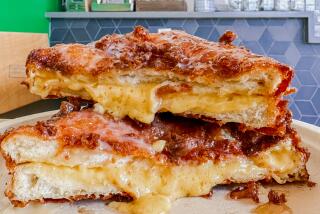Recipe: Meyer lemon-cured fillet of salmon with white asparagus, chioggia beets, toasted hazelnuts and watercress mousseline
- Share via
NOTE: Master Class columns are intended for ambitious home cooks, and some of the recipes may call for special ingredients or equipment. When that is the case, we will provide an alternative method for the main element of the dish so it can be prepared even without this ingredient or equipment.
Meyer lemon-cured salmon with spring vegetables
Total time: 1 hour, plus overnight curing and tempering times
Servings: 4
Meyer lemon-cured salmon fillets
1 pound (500 grams) skin-on top-loin salmon fillet, boned and trimmed
1 1/2 teaspoons (7 grams) kosher salt
3/4 teaspoon (3 grams) sugar
Heaping 3 tablespoons (5 grams) Meyer lemon zest, finely shaved with a Microplane (the zest of about 3 lemons), plus the finely grated zest of 1 Meyer lemon, divided
1/8 cup canola oil, more as needed
2 tablespoons butter, more as needed
1 1/2 teaspoons Maldon salt
1. Pat the salmon dry. In a small bowl, combine the kosher salt with the sugar and 5 grams lemon zest. Rub the mixture over the meat side of the salmon fillet. Vacuum seal the fillet in a bag at maximum pressure. Refrigerate the salmon for 24 hours. (If a vacuum sealer is not available, wrap the salmon tightly in plastic wrap and refrigerate for 24 hours, skin-side down.)
2. After curing the fish for 24 hours, remove the salmon from the bag (or plastic wrap), gently rinse and dry very well. Be sure to “squeegee” as much moisture from the skin as possible using a flat-sided tool, such as the back of a knife or a metal spatula, lightly rubbing it repeatedly over the skin-side of the fish and wiping it dry.
3. Cut the fillet into 4 equal portions. Place the salmon, skin side up, on a plate and set aside at room temperature for the fish to temper before sautéing.
4. Heat a large sauté pan over high heat. Add the canola oil so it reaches a depth of about one-sixteenth of an inch in the pan.
5. When the oil is hot, place the salmon fillets, skin side down, into the oil. Cook until the skin begins to crisp, about 30 seconds, then reduce the heat to medium-low and continue to cook until about one-third of each fillet is cooked through.
6. Flip the fish so it is flesh side down in the pan, add the butter and reduce the heat to low. Continue to cook until another third of each fillet is cooked through. Remove from heat.
7. Remove the salmon from the pan and set aside to rest, skin side up. Keep the fish warm until ready to plate, then garnish with the Maldon salt and remaining lemon zest.
Final assembly
1/4 cup blanched and skinned hazelnuts
Toasted hazelnut oil
Kosher salt
Meyer lemon-cured salmon fillets, cooked and warm
1/2 cup lemon hazelnut vinaigrette, or to taste
Sous-vide white asparagus
Roasted Chioggia beets
2/3 cup watercress mousseline, or to taste
1. Toast the hazelnuts: Heat the oven to 350 degrees. Place the hazelnuts on a rimmed baking sheet and bake until golden brown and fragrant, about 10 minutes. Remove from the oven and cool. Coarsely crack the hazelnuts with a mallet or the bottom of a small skillet and dress with a drizzle of hazelnut oil and kosher salt. Set aside in a warm place.
2. Place a salmon fillet in the center of each plate. Drizzle a little of the lemon hazelnut vinaigrette around it. Off to the side, arrange a few asparagus spears and lean the beets against the fish. Add a few of the roasted hazelnuts and some of the watercress mousseline. Serve immediately.
Each serving of salmon (without the other components): 349 calories; 23 grams protein; 0 carbohydrates; 0 fiber; 30 grams fat; 8 grams saturated fat; 78 mg cholesterol; 0 sugar; 635 mg sodium.
More to Read
Eat your way across L.A.
Get our weekly Tasting Notes newsletter for reviews, news and more.
You may occasionally receive promotional content from the Los Angeles Times.










